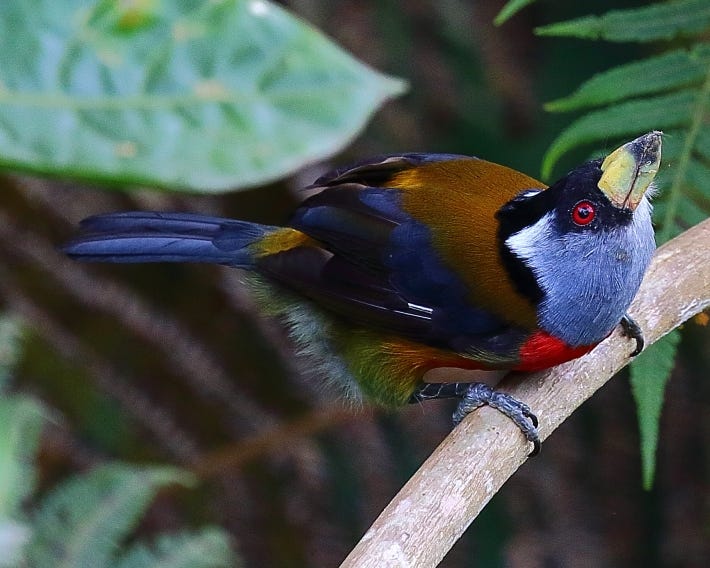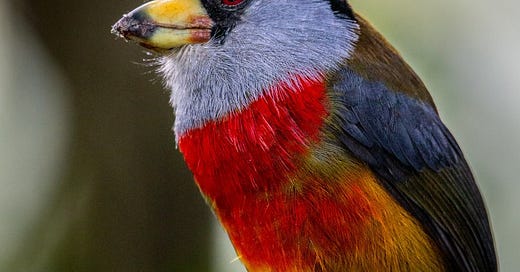This week on Bird of the Week: well. Just look at the toucan barbet.
Some bird weeks I am in it for the personality of the bird, or the call of the bird, or the weird habits of the bird, and the toucan barbet has all of those things, but I will not kid you. This week is mostly about the look of the bird, because oh my god. Caitlin called this a "damn watercolor of a bird," and she is right. It looks like it's been painted, like there is legitimate brushwork going on, like you could find this at the Met. I am continually astonished at the wonders that the world creates, and this is one of them. Another picture for god's sake!!!

I choose to believe this is a kind of smug little look. The toucan barbet is found in the wondrous cloud forests of Ecuador—one of the most biodiverse and bird-rich regions on the planet, and a place I have decided would be nice to see at some point in my life—and Colombia. One of the things I like about them is that the male and female birds look very similar to each other, which is often not the case when it comes to birds. The women birds are always getting the drab colorings while the men who have to attract them get the eye-popping plumage. More awesome-looking female birds please!
The toucan barbet is big into things like fruit and also insects. Here is a barbet—I think the same one from the previous picture—with what I think is a moth of some kind. This bird is so cute that it can make the devouring of another creature look a little adorable.

Oh, what the hell, another picture! Is this the most visually stunning bird we've done so far, just on a purely aesthetic level? I think it might be (sorry, Indian roller and Brazilian tanager, you've been displaced).

Just imagine seeing that in the trees. I'd lose my mind!
One interesting thing about the toucan barbet is that it practices what is called "cooperative breeding," where a group of barbets literally helps the parents bring their children into the world. People have written whole papers about this bird's breeding habits; here's an excerpt from the abstract of one of them (ignore the math parts, I do NOT know what they mean, also I did the bolding):
Toucan Barbets lived in permanent groups, defended a territory year-round, roosted and nested in tree cavities built by themselves, and fed mostly on fruits. Toucan Barbet groups were composed of a breeding pair and their offspring; groups were significantly smaller during the breeding (œ = 2.7 individuals) than during the nonbreeding season (œ = 3.1 individuals). Sixty-two percent of pairs had helpers, which incubated eggs, brooded and fed nestlings, and defended nestlings against predators and cavity usurpers (mainly the Plate-billed Mountain-Toucan [Andigena laminirostris]). Pairs with helpers produced more fledglings (œ = 1.3) than pairs without helpers (2 = 0.5). We suggest that the increase in reproductive success of pairs with helpers explains why cooperative breeding is favored in this species.
The toucan barbet knows it takes a village!
Unfortunately, that village is getting smaller. Some of that is because other birds—such as the aforementioned plate-billed mountain toucan—tend to dominate and even eat the toucan barbet, thus shrinking its population. But a lot of it is because human beings cannot get their fucking act together. This is a bird now listed as "near threatened" in part because of continual deforestation, as well as the habit that people have of capturing it and putting it into cages. This is what we are doing to the world, everyone.
Let's end on a happier note. One more pic, and then a fun video. Pic first.

Amazing. The video shows off the barbet's inimitable calls. One call is a very click-click-click sound, and the other is a loud sort of honk.
Honk! Love you toucan barbet.
A reminder: you can check out our complete Bird of the Week list here, and get in touch with your bird suggestions at hello@discourseblog.com.





